Western Union: from the voice of the great Manitou in the wires to the largest money transfer company
By the end of 2015, Western Union is ranked 468 in the Fortune 500. Almost 170 years ago, the company was opened as a telegraph, the founders conquered this market in the United States and then engaged in remittances. Now the company has not been transmitting telegrams for several years, but it is the largest player in the money transfer market in two hundred countries with one hundred and thirty currencies. Let's see how Western Union started its journey and what it came to.
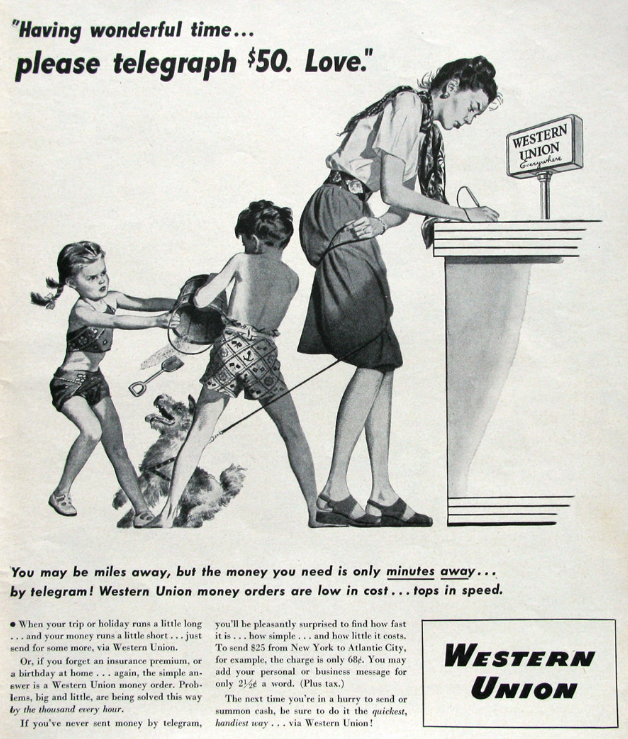
The history of Western Union must begin with the invention of the telegraph by Samuel Morse. A device that allows you to instantly transmit messages over a distance, he patented in 1840. The key or "hammer" closed and opened the electrical circuit. Automatic receiver recorded signals. The current pulses of a certain duration made the electromagnetic pen oscillating, reproducing the “dots” and “dashes” on the paper tape. The pen either squeezed the signals or applied them with ink.

Telegraph key, it is a "hammer"
')
Three years after the Morse patent was filed, Congress passed a bill in which the inventor received a grant of thirty thousand dollars for the creation of the Washington-Baltimore telegraph line 65 kilometers long.
In 1844, the line was opened, but not built the first time. Together with his partner Ezra Cornell, the inventor of the trench plow, who was digging a trench, laid the cable and buried the trench, Morse made the first attempt to lay the cable under the ground - the idea was not crowned with success. Therefore, he decided to install telegraph poles, which was cheaper due to the absence of costly insulation.
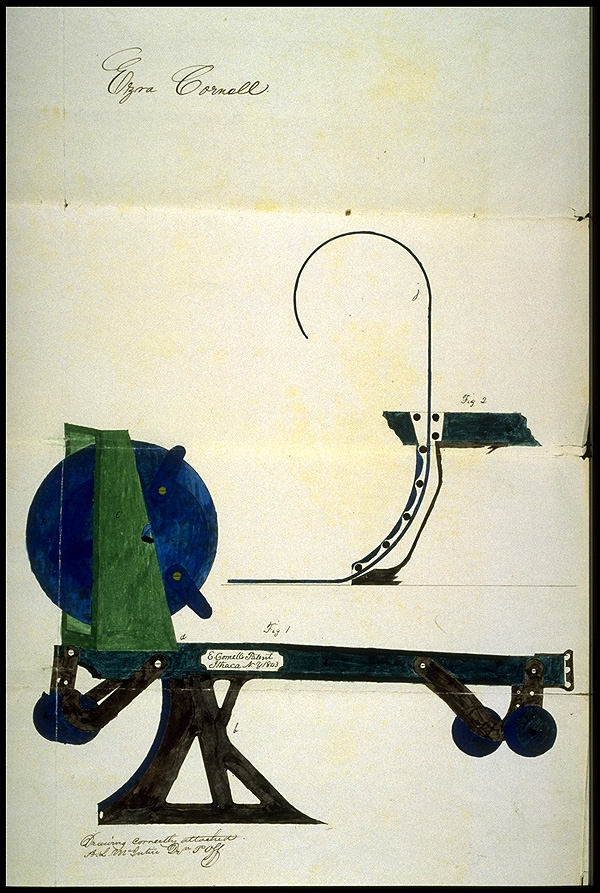
Illustration of Ezra Cornell's patent on a cable plow. A source
In 1845, Morse became the partner of the former postmaster general in two offices of the presidents - Amos Kendall. The specifics of his work made it possible to immediately understand the importance of the invention, and Kendall attracted a group of investors.
At this time in the United States began a real "telegraph boom." Morse was selling licenses for his invention, and by 1851 fifty independent telegraph companies opened in the country.
In 1849, the sheriff of Monroe County, New York, Hyrum Sibley, and Judge Samuel Selden, the owner of the rights to the telegraph patents of Royal House , analyzed the market and concluded that there was no point in building new telegraph lines. There are already a lot of them. Instead, it is better to buy existing companies and combine them into one system. In April 1851, they registered the New York and Mississippi Valley Printing Telegraph Company (NYMVPTC). Seven years later, the name changed to “Western Union” - “Western Union”.
The name reflected the original goal of creating a single and unified system of telegraph lines. In three years, the number of Western Union offices has grown to 4,000. The company's capital has increased from 220 thousand to 48 million dollars.
The high cost of telegrams - $ 20 per message in 1854 - did not attract a large number of customers. In the West, the United States operated two systems owned by 13 companies. Their owners, who did not receive the desired profit, sold the company to Hyrum Sibyl. In the same years, the Founders of Western Union bought out a patent for Morse telegraph - more advanced than Royal House’s version.
Wars always require operational communications, and in April 1861, the US was engulfed in a civil war between North and South. It took ten days to send a message from St. Joseph to Sacramento in California — it was the work of a pony express, a postal service that lasted only a year and a half. The founders of the company built paths of 3,100 kilometers between the Atlantic and Pacific Ocean, from St. Joseph in Missouri to Sacramento. Every ten to fifteen miles couriers changed horses at special stations. In those days, workers received one dollar a week. Pony Express couriers earned twenty-five.

Wanted young and brave guys, no older than eighteen, ready to risk their lives every day
In 1860, Congress announced a tender for the creation of a transcontinental line. Few people believed in the line, including President Abraham Lincoln. Even if the company succeeds in putting up pillars for two thousand miles over mountains and plains, the Indians can destroy the line.
Hyrum Sibley with Western Union turned out to be the only participant in the tender. Company agent Edward Creighton set out paths for the telegraph lines and became the head of the construction brigade, starting construction from the East. From the West to him went James Gamble. During the day, the length of the line increased by ten to twelve miles. To protect the lines from the Indians, businessmen convinced them that the telegraph was the voice of the great spirit Manitou (Perhaps the builders of a thirty-meter telescope in Hawaii, who also had problems with local residents, would have to learn from their experience).
October 24, 1861, 112 days after the start of work, the telegraph was combined into a single transcontinental line in Salt Lake City. In 1867, Russia sold Alaska to the United States for $ 7.2 million. Western Union was granted the right to lay lines along the military and postal routes, including rail lines, that year. And the pony express service collapsed, unable to withstand the competition and the constant attacks of gangsters on couriers.
Twenty years earlier, in 1841, it took 110 days for news of the death of US President William Henry Harrison to reach Los Angeles.
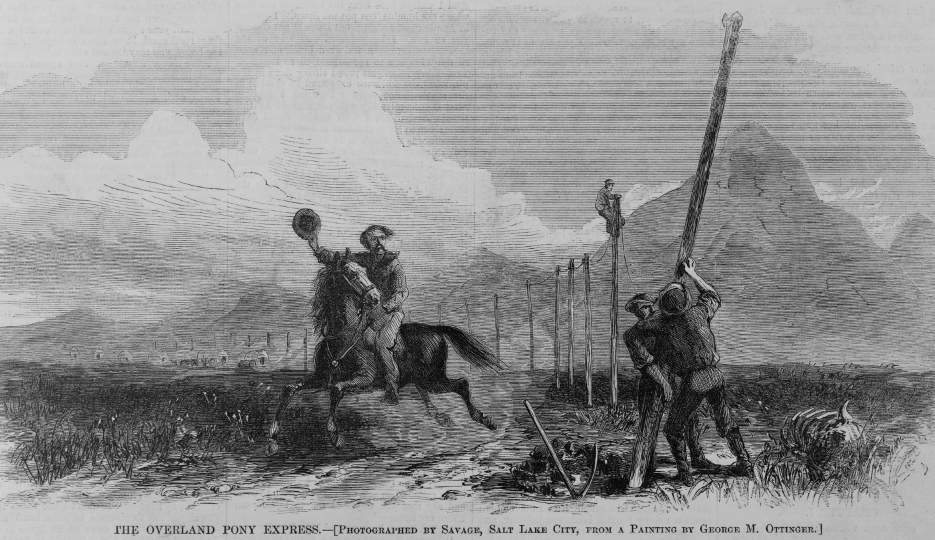
Illustration depicting the laying of the transcontinental telegraph line. A Pony Express employee welcomes builders.
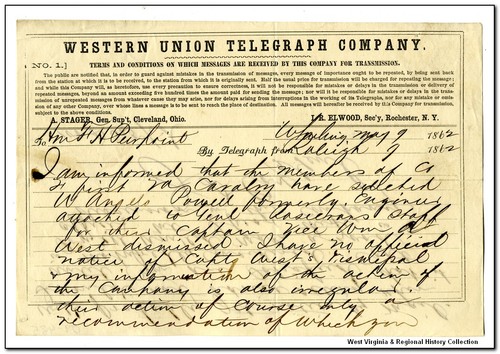
Telegram of May 6, 1862
In 1877, Western Union made a mistake that you can still regret. The president of the company decided that the technology of voice transmission over a distance was an unnecessary toy, and refused to buy a patent for the invention of Alexander Bell for $ 100,000.
The company's opinion changed after Bell Telephone Company opened the first line and began to develop its business. Then Western Union decided to compete with Bell, and hired Thomas Edison, who created a new microphone. Initially, the telegraph company had a head start in the form of a ready-made extensive network of wires.
The case ended in court. Western Union lost the case , and the telephone lines built by it were in the hands of the Bell Telephone Company.
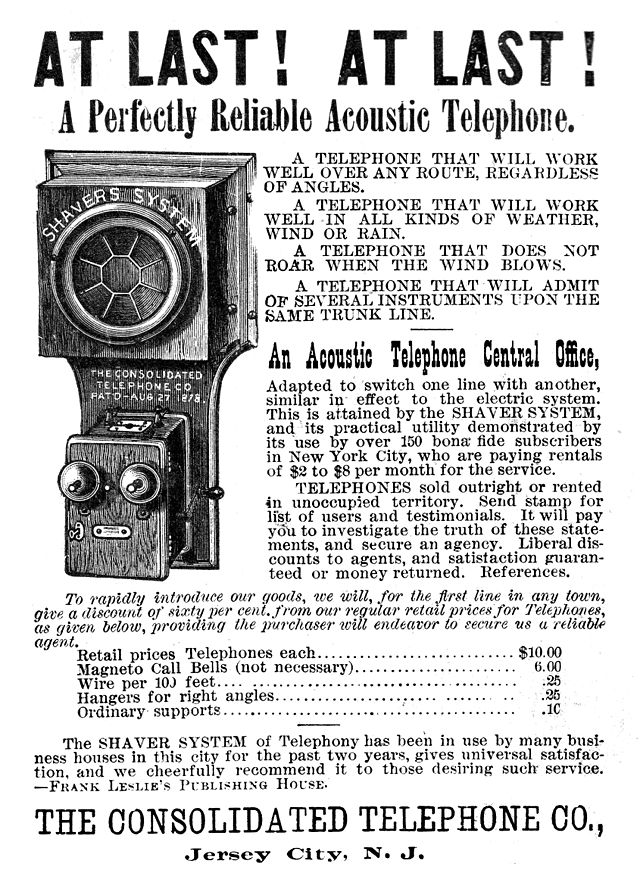
Advertising Bell Telephone Company, 1886
Sending money by mail is not the best idea. But for a long time, this was the only way to send money using the existing communications infrastructure. Money in the mail in Russia sent from 1781. In the XIX century, a new service appeared - postal orders. Imagine that two branches located in different cities received a thousand rubles each. A young man comes to the first compartment and asks to send two rubles to his mother. An employee of the post office pulls out a two-ruble special coupon from a special accounting book and sends it to the recipient via postal service, and the young man’s mother already takes the cash, presenting the coupon.
It is worth noting that in the XIX century Russia was forbidden to invest in envelopes. Now, in the 21st century, there are different ways to send money to another person. You can use Webmoney, PayPal, or Yandex.Money e-wallets, transfer funds via Internet Bank, from card to card or from account to account. The Internet has simplified the work of the company, allowing it to add to the package of services the possibility of sending money online with bank cards. However, people still try to send bills by mail, masking them with foil or putting them between photos in an album. Why are they trying to do this? To avoid fees for transfers. Although the services of “Western Union” and its analogues will cost from 1.5% of the amount .
An extensive telegraph network across the country and beyond, passing through Alaska to Russia and Europe, allowed Western Union to begin providing telegraphic transfers in 1871. In this case, they sent not coupons or forms from the accounting book, but information about the recipient and the amount of the payment. This service turned out to be in demand, and for the first nine months, the profit amounted to 8.9 thousand dollars, which in translation in 2016 is approximately 167 thousand dollars. In 1876, the company conducted 37,190 transfers in the amount of $ 2.624 million, with an average transfer amount of $ 70. This is more than 56 million dollars in 2016 prices.

The largest telegraph lines in 1891
In wartime, people continued to transfer money. For 1944, the amount amounted to 716 million dollars, and the number of transfers - 16 thousand. The soldiers received money at the front or sent money to families and friends in their homeland.
In peacetime, the service was even more in demand. “Imagine that you are enjoying a wonderful holiday under the sun. But in the midst of this paradise on Earth, you run out of cash, "- advertises the transfer of money by Western Union, -" There is only one way to safely send money - by wire. "
In 2015, Western Union made 262 million remittances between customers for a total amount of $ 82 billion. In two hundred countries, the company has more than 500,000 points of receiving and sending money.
The service, which was originally considered optional, and built on the existing infrastructure created for the transmission of telegrams, has become a core business for Western Union. Until 2006, the company continued to send telegrams, but the development of telephone lines, mobile communications, text messages, and e-mail defeated this type of communication. In 2006, Western Union sent only 20,000 telegrams, that is, less than money transfers five years after the launch of the service in 1876.

Morse and his telegraph
The history of Western Union must begin with the invention of the telegraph by Samuel Morse. A device that allows you to instantly transmit messages over a distance, he patented in 1840. The key or "hammer" closed and opened the electrical circuit. Automatic receiver recorded signals. The current pulses of a certain duration made the electromagnetic pen oscillating, reproducing the “dots” and “dashes” on the paper tape. The pen either squeezed the signals or applied them with ink.

Telegraph key, it is a "hammer"
')
Three years after the Morse patent was filed, Congress passed a bill in which the inventor received a grant of thirty thousand dollars for the creation of the Washington-Baltimore telegraph line 65 kilometers long.
In 1844, the line was opened, but not built the first time. Together with his partner Ezra Cornell, the inventor of the trench plow, who was digging a trench, laid the cable and buried the trench, Morse made the first attempt to lay the cable under the ground - the idea was not crowned with success. Therefore, he decided to install telegraph poles, which was cheaper due to the absence of costly insulation.

Illustration of Ezra Cornell's patent on a cable plow. A source
In 1845, Morse became the partner of the former postmaster general in two offices of the presidents - Amos Kendall. The specifics of his work made it possible to immediately understand the importance of the invention, and Kendall attracted a group of investors.
At this time in the United States began a real "telegraph boom." Morse was selling licenses for his invention, and by 1851 fifty independent telegraph companies opened in the country.
Western Union seizes the telegraph market
In 1849, the sheriff of Monroe County, New York, Hyrum Sibley, and Judge Samuel Selden, the owner of the rights to the telegraph patents of Royal House , analyzed the market and concluded that there was no point in building new telegraph lines. There are already a lot of them. Instead, it is better to buy existing companies and combine them into one system. In April 1851, they registered the New York and Mississippi Valley Printing Telegraph Company (NYMVPTC). Seven years later, the name changed to “Western Union” - “Western Union”.
The name reflected the original goal of creating a single and unified system of telegraph lines. In three years, the number of Western Union offices has grown to 4,000. The company's capital has increased from 220 thousand to 48 million dollars.
The high cost of telegrams - $ 20 per message in 1854 - did not attract a large number of customers. In the West, the United States operated two systems owned by 13 companies. Their owners, who did not receive the desired profit, sold the company to Hyrum Sibyl. In the same years, the Founders of Western Union bought out a patent for Morse telegraph - more advanced than Royal House’s version.
Wars always require operational communications, and in April 1861, the US was engulfed in a civil war between North and South. It took ten days to send a message from St. Joseph to Sacramento in California — it was the work of a pony express, a postal service that lasted only a year and a half. The founders of the company built paths of 3,100 kilometers between the Atlantic and Pacific Ocean, from St. Joseph in Missouri to Sacramento. Every ten to fifteen miles couriers changed horses at special stations. In those days, workers received one dollar a week. Pony Express couriers earned twenty-five.

Wanted young and brave guys, no older than eighteen, ready to risk their lives every day
In 1860, Congress announced a tender for the creation of a transcontinental line. Few people believed in the line, including President Abraham Lincoln. Even if the company succeeds in putting up pillars for two thousand miles over mountains and plains, the Indians can destroy the line.
Hyrum Sibley with Western Union turned out to be the only participant in the tender. Company agent Edward Creighton set out paths for the telegraph lines and became the head of the construction brigade, starting construction from the East. From the West to him went James Gamble. During the day, the length of the line increased by ten to twelve miles. To protect the lines from the Indians, businessmen convinced them that the telegraph was the voice of the great spirit Manitou (Perhaps the builders of a thirty-meter telescope in Hawaii, who also had problems with local residents, would have to learn from their experience).
October 24, 1861, 112 days after the start of work, the telegraph was combined into a single transcontinental line in Salt Lake City. In 1867, Russia sold Alaska to the United States for $ 7.2 million. Western Union was granted the right to lay lines along the military and postal routes, including rail lines, that year. And the pony express service collapsed, unable to withstand the competition and the constant attacks of gangsters on couriers.
Twenty years earlier, in 1841, it took 110 days for news of the death of US President William Henry Harrison to reach Los Angeles.

Illustration depicting the laying of the transcontinental telegraph line. A Pony Express employee welcomes builders.

Telegram of May 6, 1862
Western Union vs Bell
In 1877, Western Union made a mistake that you can still regret. The president of the company decided that the technology of voice transmission over a distance was an unnecessary toy, and refused to buy a patent for the invention of Alexander Bell for $ 100,000.
The company's opinion changed after Bell Telephone Company opened the first line and began to develop its business. Then Western Union decided to compete with Bell, and hired Thomas Edison, who created a new microphone. Initially, the telegraph company had a head start in the form of a ready-made extensive network of wires.
The case ended in court. Western Union lost the case , and the telephone lines built by it were in the hands of the Bell Telephone Company.

Advertising Bell Telephone Company, 1886
Money transfers
Sending money by mail is not the best idea. But for a long time, this was the only way to send money using the existing communications infrastructure. Money in the mail in Russia sent from 1781. In the XIX century, a new service appeared - postal orders. Imagine that two branches located in different cities received a thousand rubles each. A young man comes to the first compartment and asks to send two rubles to his mother. An employee of the post office pulls out a two-ruble special coupon from a special accounting book and sends it to the recipient via postal service, and the young man’s mother already takes the cash, presenting the coupon.
It is worth noting that in the XIX century Russia was forbidden to invest in envelopes. Now, in the 21st century, there are different ways to send money to another person. You can use Webmoney, PayPal, or Yandex.Money e-wallets, transfer funds via Internet Bank, from card to card or from account to account. The Internet has simplified the work of the company, allowing it to add to the package of services the possibility of sending money online with bank cards. However, people still try to send bills by mail, masking them with foil or putting them between photos in an album. Why are they trying to do this? To avoid fees for transfers. Although the services of “Western Union” and its analogues will cost from 1.5% of the amount .
An extensive telegraph network across the country and beyond, passing through Alaska to Russia and Europe, allowed Western Union to begin providing telegraphic transfers in 1871. In this case, they sent not coupons or forms from the accounting book, but information about the recipient and the amount of the payment. This service turned out to be in demand, and for the first nine months, the profit amounted to 8.9 thousand dollars, which in translation in 2016 is approximately 167 thousand dollars. In 1876, the company conducted 37,190 transfers in the amount of $ 2.624 million, with an average transfer amount of $ 70. This is more than 56 million dollars in 2016 prices.

The largest telegraph lines in 1891
In wartime, people continued to transfer money. For 1944, the amount amounted to 716 million dollars, and the number of transfers - 16 thousand. The soldiers received money at the front or sent money to families and friends in their homeland.
In peacetime, the service was even more in demand. “Imagine that you are enjoying a wonderful holiday under the sun. But in the midst of this paradise on Earth, you run out of cash, "- advertises the transfer of money by Western Union, -" There is only one way to safely send money - by wire. "
In 2015, Western Union made 262 million remittances between customers for a total amount of $ 82 billion. In two hundred countries, the company has more than 500,000 points of receiving and sending money.
The service, which was originally considered optional, and built on the existing infrastructure created for the transmission of telegrams, has become a core business for Western Union. Until 2006, the company continued to send telegrams, but the development of telephone lines, mobile communications, text messages, and e-mail defeated this type of communication. In 2006, Western Union sent only 20,000 telegrams, that is, less than money transfers five years after the launch of the service in 1876.
Source: https://habr.com/ru/post/395899/
All Articles